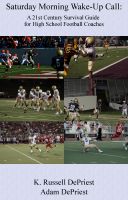
This is a five-receiver set in which we are running 3 verticals against a cover 2. The read will be for one of the inside receivers on the strong side. The weak #2 receiver is running a flag to pull the weak-side safety. The #3 receiver has to get inside the strong-side safety, then get vertical so he doesn’t get to the other safety and has to get over the dropping linebacker. The strong #2 receiver has to get deep and stay outside the safety, but cannot get too far outside to draw the flat corner deep. The other key is for these receivers not to get caught up with any linebackers that can knock them off of their route. Good route running will give the quarterback an easy read of the strong safety and an easy completion down the field.

Here is the same play against a cover 3. Everyone has the same assigned route, but our #3 and #2 receivers on the strong side have to run their route a little differently. First, they will both may have a defender lined up on them that they will have to maneuver against. For instance, #2 needs to know that in cover 3, that SS will have flats, so he will need to get inside of him but then will need to get vertical keeping two things in mind: first, stay away from the free safety and second, get far enough inside the cornerback who is playing the deep outside third. The #3 receiver must get off of the linebacker and go hard in front of the free safety. Again, as long as the receivers are not held up by the underneath coverage and they run good routes, this is an easy completion for the quarterback.
Another note about the difference in these two plays against cover 2 and cover 3 is alignment. If the receivers notice the coverage before the play, then they should adjust accordingly. In cover 2, the #2 and #3 receivers should widen to give them more room and better angles with the strong-side safety. The key for #2 is not to get too wide or stay too wide and draw the coverage of the flat corner. In cover 3, both receivers should align closer to the middle of the field. This allows them to split the safety sooner, giving the quarterback an quicker and easier read. The difficulty for the #3 is getting through any traffic from the linebackers.
These are easy reads for the quarterback as long as all receivers do their job. For instance, the #1 strong receiver can't loaf, or his CB will get on the back of the #2 receiver (in either coverage). Same can be said about the weak #2 receiver. If he doesn't pull that weak safety over in cover 2, then the weak safety can make a play on the #3. If the weak #1 aligns too far inside versus cover 3, then it shortens the distance the CB is to the middle of the field, possibly allowing him to be a factor in the play as he reads the quarterback. Last note for the quarterback is to trust your receivers to beat linebackers. If he is waiting to see if they will beat the dropping linebackers, then he is waiting too long. He has to know that a dropping linebacker cannot keep up with a receiver that is running full speed. He also cannot leave that pass short as that would allow that LB to come into play.







No comments:
Post a Comment